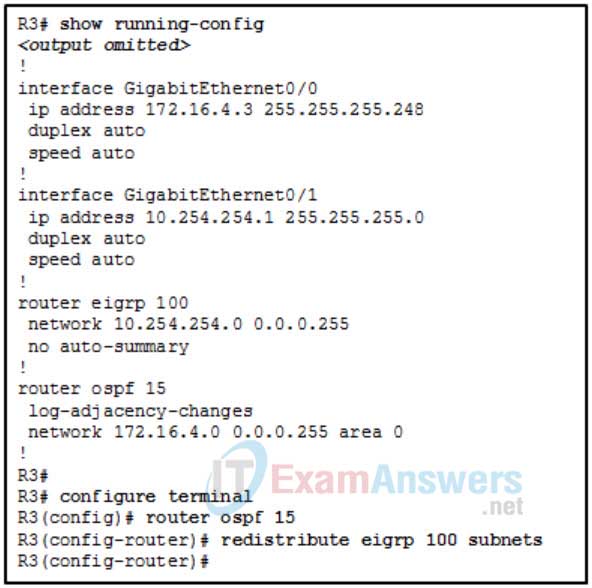1. Which characteristic describes both ABRs and ASBRs that are implemented in a multiarea OSPF network?
- They usually have many local networks attached.
- They both run multiple routing protocols simultaneously.
- They are required to perform any summarization or redistribution tasks.
- They are required to reload frequently and quickly in order to update the LSDB.
2. Which is an OSPF feature that can provide consolidation of type 3 LSAs?
- automatic summarization
- manual route summarization
- DR/BDR elections
- autonomous system boundary routers
3. Which type of area best describes a stub area?
- a small area
- an area with only one router
- an area with no externally learned routes
- an area that is discontiguous from the backbone area
4. Refer to the exhibit. On which router or routers should OSPF summarization be configured to summarize the two Ethernet LANs in Area 2?

- R0-A
- R0-C
- R2-A
- R0-C and R2-A
5. Which command can be used to verify the contents of the LSDB in an OSPF area?
- show ip ospf database
- show ip ospf interface
- show ip ospf neighbor
- show ip route ospf
6. An OSPF enabled router is processing learned routes to select best paths to reach a destination network. What is the OSPF algorithm evaluating as the metric?
- The amount of packet delivery time and slowest bandwidth.
- The number of hops along the routing path.
- The amount of traffic and probability of failure of links.
- The cumulative bandwidth that is used along the routing path.
7. What information is needed when configuring an OSPF virtual link between two Layer 3 devices?
- the OSPF process ID of the remote router
- the IP address of the remote router
- the router ID of the remote router
- the router name of the Area 0 DR
8. Refer to the exhibit. While configuring a multiarea OSPF topology, a network administrator implements the redistribute eigrp 100 subnets command. Which type of OSPF router is being configured?

- ASBR
- internal
- internal backbone
- ABR
9. Which type of OSPF area makes use of LSA type 7s?
- backbone
- stub
- not-so-stubby
- totally stubby
10. What is the correct order of statements for calculating the best path in an OSPF network?
- A, B, C
- B, C, A
- B, A, C
- C, A, B
11. Which type of OSPF LSA represents an external route and is propagated across the entire OSPF domain?
- type 1
- type 2
- type 3
- type 4
- type 5
12. An OSPF ABR router summarizes all internal area 1 routes into one OSPF interarea summary route. How does this type of route get inserted into the routing table?
- The router injects into the backbone a single type 5 LSA that describes the summary route.
- Cisco IOS automatically creates a summary route on the router to the Null0 interface in order to prevent routing loops.
- This route summarization was configured via the summary-address address mask router configuration mode command.
- An entry with a router designator OIA will be inserted into the routing table.
“Do I Know This Already?” Quiz Answers:
1. How many OSPF link-state advertisements (LSAs) are used for routing traditional IPv4 packets?
- Two
- Three
- Five
- Six
- Seven
2. What is the LSA Age field in the LSDB used for?
- Version control, to ensure that the most recent LSA is present
- To age out old LSAs by removing an LSA when its age reaches zero
- For troubleshooting, to identify exactly when the LSA was advertised
- To age out old LSAs by removing an LSA when it reaches 3600 seconds
3. Which LSA type exists in all OSPF areas?
- Network
- Summary
- Router
- AS external
4. True or false: When an ABR receives a network LSA, the ABR forwards the network LSA to the other connected areas.
- True
- False
5. An OSPF stub area blocks which types of LSAs from being injected into the area by the ABR? (Choose two.)
- Type 1 LSA
- Type 3 LSA
- Type 4 LSA
- Type 5 LSA
6. True or false: An OSPF not-so-stubby area (NSSA) automatically creates a default route when a Type 5 LSA is blocked on the ABR from being injected into the NSSA.
- True
- False
7. OSPF automatically assigns a link cost to an interface based on what reference bandwidth?
- 100 Mbps
- 1 Gbps
- 10 Gbps
- 40 Gbps
8. True or false: If two different routers are redistributing the same network (such as 10.1.1.0/24) as an OSPF external Type 2 route, and they have the same metric, both paths are installed on a downstream router.
- True
- False
9. True or false: Breaking a large OSPF topology into smaller OSPF areas can be considered a form of summarization.
- True
- False
10. Summarizing external OSPF routes on is accomplished by using the _____.
- interface configuration command summary-address network prefix-length
- OSPF process configuration command summary-address network subnet-mask
- OSPF process configuration command area area-id range network subnet-mask
- interface configuration command area area-id summary-address network subnet-mask
11. When a Type 3 LSA is received on a nonbackbone area, what does the ABR do?
- Discards the Type 3 LSA and does not process it
- Installs the Type 3 LSA for only the area for which it was received
- Advertises the Type 3 LSA to the backbone area and displays an error
- Advertises the Type 3 LSA to the backbone area
12. True or false: Virtual link is another term for an OSPF-enabled GRE tunnel.
- True
- False
